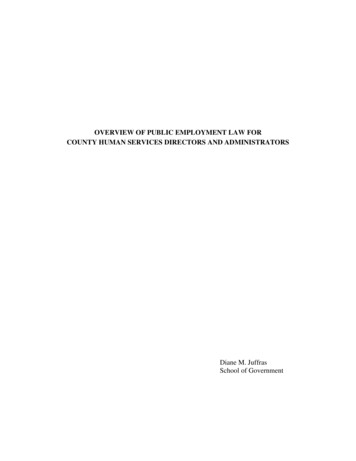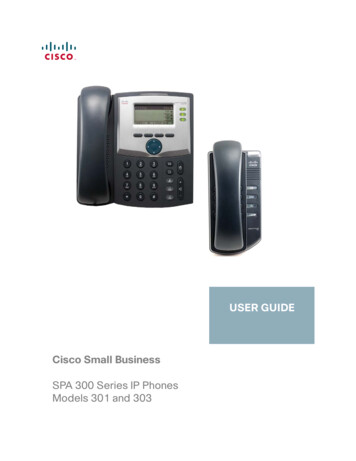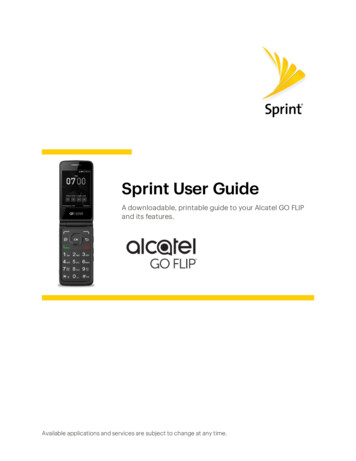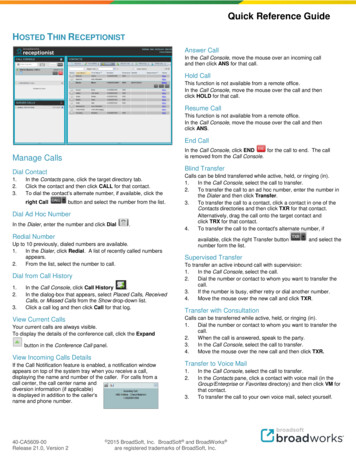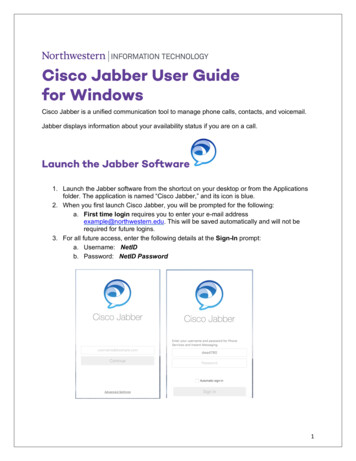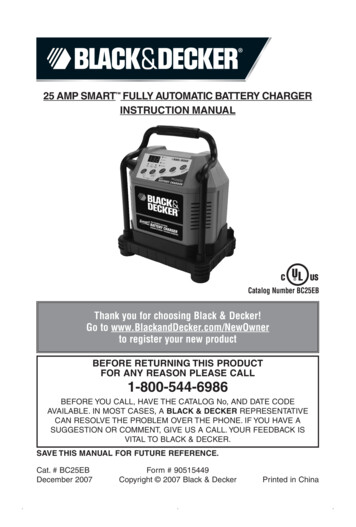
Transcription
BC25EB ManualEN 121007.qxp12/10/20078:42 AMPage i25 AMP SMART FULLY AUTOMATIC BATTERY CHARGERINSTRUCTION MANUALCatalog Number BC25EBThank you for choosing Black & Decker!Go to www.BlackandDecker.com/NewOwnerto register your new productBEFORE RETURNING THIS PRODUCTFOR ANY REASON PLEASE CALL1-800-544-6986BEFORE YOU CALL, HAVE THE CATALOG No, AND DATE CODEAVAILABLE. IN MOST CASES, A BLACK & DECKER REPRESENTATIVECAN RESOLVE THE PROBLEM OVER THE PHONE. IF YOU HAVE ASUGGESTION OR COMMENT, GIVE US A CALL. YOUR FEEDBACK ISVITAL TO BLACK & DECKER.SAVE THIS MANUAL FOR FUTURE REFERENCE.Cat. # BC25EBDecember 2007Form # 90515449Copyright 2007 Black & DeckerPrinted in China
BC25EB ManualEN 121007.qxp12/10/20078:42 AMPage 1GENERAL SAFETY WARNINGS AND INSTRUCTIONS FOR ALL APPLIANCES READ ALL INSTRUCTIONSREAD ALL INSTRUCTIONSWARNING: Read all instructions before operating product. Failure to follow all instructions listed below mayresult in electric shock, fire and/or serious injury. AVOID DANGEROUS ENVIRONMENTS: Don’t use appliances in damp or wet locations. Don’t use appliances in the rain. KEEP CHILDREN AWAY. All visitors should be kept at a distance from work area. STORE IDLE APPLIANCES INDOORS. When not in use, appliances should be stored indoors in dry, and highor locked-up place – out of reach of children. DON’T FORCE APPLIANCE. It will do the job better and with less likelihood of a risk of injury at the rate for which itwas designed. USE RIGHT APPLIANCE. Do not use the appliance for any job except that for which it is intended. DRESS PROPERLY. Do not wear loose clothing or jewelry. They can be caught in moving parts. Rubber glovesand substantial, non-skid footwear are recommended when working outdoors. Wear protective hair covering tocontain long hair. USE SAFETY GLASSES AND OTHER SAFETY EQUIPMENT. Use safety goggles or safety glasses with side shields,complying with applicable safety standards and, when needed, a face shield. Also use face or dust mask if operationis dusty. This applies to all persons in the work area. Also use a hard hat, hearing protection, gloves, safety shoesand dust collection systems when specified or required. Safety glasses or the like are available at extra cost at yourlocal dealer or Black & Decker Service Center. DON’T ABUSE CORD. Never carry appliance by cord or yank it to disconnect from receptacle. Keep cord from heat, oil,and sharp edges. DON’T OVERREACH. Keep proper footing and balance at all times. DISCONNECT APPLIANCES. Disconnect the appliance from the power supply when not in use, beforeservicing, and when changing accessories such as blades and the like. AVOID UNINTENTIONAL STARTING. Don’t carry plugged-in appliance with finger on switch. Be sure switch is offwhen plugging in. GROUND FAULT CIRCUIT INTERRUPTER (GFCI) protection should be provided on the circuits or outlets to beused. Receptacles are available having built in GFCI protection and may be used for this measure of safety. USE OF ACCESSORIES AND ATTACHMENTS. The use of any accessory or attachment not recommended for usewith this appliance could be hazardous. Note: Refer to the accessory section of this manual for further details. STAY ALERT. Watch what you are doing. Use common sense. Do not operate tool when you are tired. CHECK DAMAGED PARTS. Before further use of the tool, a guard or other part that is damaged should becarefully checked to determine that it will operate properly and perform its intended function. Check for alignment ofmoving parts, binding of moving parts, breakage of parts, mounting, and any other conditions that may affect itsoperation. A guard or other part that is damaged should be properly repaired or replaced by an authorized servicecenter unless otherwise indicated elsewhere in this instruction manual. Have defective switches replaced byauthorized service center. Do not use tool if switch does not turn it on and off. DO NOT OPERATE portable electric tools near flammable liquids or in gaseous or explosive atmospheres.Motors in these tools normally spark, and the sparks might ignite fumes. OUTDOOR USE EXTENSION CORDS. When tool is used outdoors, use only extension cords intended for use outdoorsand so marked.Volts120V240VAmpere RatingMoreNot moreThanThan0 66 1010 1212 16Minimum Gage for Cord SetsTotal Length of Cord in 0-5051-100101-200(0-15,2m) (15,2-30,4m) American Wire Gage1818161416161612161414121412Not Recommended EXTENSION CORDS. Make sure your extension cord is in good condition. When using an extension cord, be sure touse one heavy enough to carry the current your product will draw. An undersized cord will cause a drop in line voltageresulting in loss of power and overheating. The following table shows the correct size to use depending on cord lengthand nameplate ampere rating. If in doubt, use the next heavier gage. The smaller the gage number, the heavier the cord.1
BC25EB ManualEN 121007.qxp12/10/20078:42 AMPage 2SAFETY GUIDELINES / DEFINITIONSDANGER: Indicates an imminently hazardous situation which, if not avoided, will result in death or serious injury.WARNING: Indicates a potentially hazardous situation which, if not avoided, could result in death or serious injury.CAUTION: Indicates a potentially hazardous situation which, if not avoided, may result in minor or moderate injury.CAUTION: Used without the safety alert symbol indicates potentially hazardous situation which, if not avoided, may result inproperty damage.RISK OF UNSAFE OPERATION. When using tools or equipment, basic safety precautions should always be followed toreduce the risk of personal injury. Improper operation, maintenance or modification of tools or equipment could result inserious injury and property damage. There are certain applications for which tools and equipment are designed. Black &Decker strongly recommends that this product NOT be modified and/or used for any application other than for which itwas designed. Read and understand all warnings and operating instructions before using any tool or equipment.IMPORTANT SAFETY INSTRUCTIONSWARNING: This product or its power cord contains lead, a chemical known to the State of California tocause cancer and birth defect or other reproductive harm. Wash hands after handling.WARNING: BURST HAZARD: Do not use the unit for charging dry-cell batteries that are commonly used withhome appliances. These batteries may burst and cause injury to persons and damage property. Use the unit forcharging/boosting a LEAD-ACID battery only. It is not intended to supply power to a low-voltage electrical system otherthan in a starter-motor application. NEVER EQUALIZE A GEL OR AGM BATTERY, these may burst and causeSERIOUS INJURY and property damage.WARNING: SHOCK HAZARD: If an extension cord is used, make sure that:a) the pins of extension cord are the same number, size and shape as those in the charger,b) the extension cord is properly wired and in good electrical condition,c) the wire size is large enough for the AC rating of the charger as indicated in the table on page 1. Do not operate unit with damaged cord or plug; or if the unit has received a sharp blow, been dropped, orotherwise damaged in any way. Do not disassemble the unit; take it to a qualified service technician when serviceor repair is required. Incorrect reassembly may result in a risk of electric shock or fire, and will void warranty. Use of an attachment not supplied, recommended or sold by manufacturer specifically for use with this unitmay result in a risk of electrical shock and injury to persons. NEVER submerge this unit in water; do not expose it to rain, snow or use when wet. To reduce risk of electric shock, disconnect the unit from any power source before attempting maintenance orcleaning. Turning off controls without disconnecting will not reduce this risk.WARNING: RISK OF EXPLOSIVE GASES Working in the vicinity of a lead acid battery is dangerous. Batteries generate explosive gases during normalbattery operation. For this reason, it is of the utmost importance that each time before using the charger youread this manual and follow instructions exactly. To reduce the risk of battery explosion, follow these instructions and those published by the batterymanufacturer and manufacturer of any equipment you intend to use in the vicinity of the battery. Reviewcautionary markings on these products and on the engine. This equipment employs parts (switches, relays, etc.) that produce arcs or sparks. Therefore, if used in agarage or enclosed area, the unit MUST be placed not less than 18 inches above the floor. THIS UNIT IS NOT FOR USE BY CHILDREN AND SHOULD ONLY BE OPERATED BY ADULTS.CAUTION: TO REDUCE THE RISK OF INJURY OR PROPERTY DAMAGE: Pull cord by plug rather than cord when disconnecting the 120V AC Charging Adapter from the unit. NEVER ATTEMPT TO JUMP-START OR CHARGE A FROZEN BATTERY. To recharge this unit, use only the supplied AC Charging Adapter. Vehicles that have on-board computerized systems may be damaged if vehicle battery is jump-started. Beforejump-starting, read the vehicle’s owner’s manual to confirm that external-starting assistance is suitable. When working with lead acid batteries, always make sure immediate assistance is available in case of accidentor emergency. Always have protective eyewear when using this product: contact with battery acid may cause blindnessand/or severe burns. Be aware of first aid procedures in case of accidental contact with battery acid.2
BC25EB ManualEN 121007.qxp12/10/20078:42 AMPage 3 Have plenty of fresh water and soap nearby in case battery acid contacts skin. If battery acid contacts skin or clothing, wash immediately with soap and water for at least 10 minutes and getmedical attention immediately. Never smoke or allow a spark or flame in vicinity of vehicle battery, engine or charger. Remove personal metal items such as rings, bracelets, necklaces and watches when working with a lead acidbattery. A lead acid battery can produce a short circuit current high enough to weld a ring, or the like of a metal,causing a severe burn. Never allow battery acid to come in contact with this unit. Do not operate this unit in a closed area or restrict ventilation in any way. FIRST AID – SKIN: If battery acid comes in contact with skin, rinse immediately with water, then washthoroughly with soap and water. If redness, pain, or irritation occurs, seek immediate medical attention.EYES: If battery acid comes in contact with eyes, flush eyes immediately, for a minimum of 15 minutes andseek immediate medical attention. GROUNDING AND AC POWER CORD CONNECTION INSTRUCTIONS – Charger should be grounded to reducerisk of electric shock. Charger is equipped with an electric cord having an equipment-grounding conductor anda grounding plug. The plug must be plugged into an outlet that is properly installed and grounded inaccordance with all local codes and ordinances.The battery charger is for use on a nominal 120 volt circuit, and has a grounding plug that looks like the plug illustratedin Figure A. A temporary adapter, which looks like the plug illustrated in Figures B and C may be used to connect thisplug to a two-pole receptacle as shown in Figure B if a properly grounded outlet is not available. The temporary adaptershould be used only until a properly grounded outlet can be installed by a qualified electrician.DANGER – Before using adapter as illustrated, be certain that the center screw of the outlet is grounded. Thegreen-colored rigid ear or lug extending from the adapter must be connected to a properly grounded outlet. Makecertain it is grounded. If necessary, replace the original outlet cover plate screw with a longer screw that will secureadapter ear or lug to outlet cover plate and make ground connection to grounded outlet.DANGER – Never alter AC cord or plug provided – if it will not fit outlet, have proper outlet installed by aqualified electrician. Improper connection can result in a risk of an electric shock.Preparing to Charge1. Determine voltage of battery to be charged by referring to the vehicle manual.2. it is necessary to remove battery from vehicle to charge, or to clean terminals, always remove groundedterminal from battery first. Make sure all accessories in the vehicle are off, so as not to cause an arc.3. Clean battery terminals. Do not allow corrosion to come in contact with eyes.4. Add distilled water in each cell until battery acid reaches level specified by battery manufacturer. This helpspurge excessive gas from cells. Do not overfill. For a battery without cell caps (maintenance free), carefullyfollow manufacturer's charging instructions.5. Study all battery manufacturer’s specific precautions, such as removing or not removing cell caps whilecharging, and recommended rates of charge.6. Remove battery completely from boat/airplane or any confined area before charging.7. Make sure the initial charging rate does not exceed battery manufacturer’s requirement.Charger Location1. Locate charger as far away from battery as cables permit.2. NEVER place charger directly above battery being charged; gases from battery will corrode and damage charger.3. NEVER allow battery acid to drip on charger when reading gravity or filling battery.4. NEVER operate charger in a closed-in area or restrict ventilation in any way.5. Marine batteries must be removed and charged on shore.6. Do not set a battery on top of charger.3
BC25EB ManualEN 121007.qxp12/10/20078:42 AMPage 4DC Connection Precautions1. Connect and disconnect DC output clamps only after removing AC cord from electric outlet.2. Never allow clamps to touch each other.3. Attach clamps to battery and chassis as indicated in “Battery Installed in Vehicle” steps 5 and 6, and in“Battery Outside of Vehicle” steps 2, 4 and 5.Follow these steps when the battery is installed in a vehicle. A spark near the battery may cause an explosion.CAUTION: TO REDUCE RISK OF A SPARK NEAR THE BATTERY:1. Position AC and DC cords away from hood, door, or moving engine parts.2. Stay clear of fan blades, belts, pulleys, and other parts that can cause injury to persons.3. Check polarity of battery posts. POSITIVE (POS, P, ) battery post usually has larger diameter than NEGATIVE(NEG, N, –) post.4. Determine which post of battery is grounded (connected) to the chassis. If negative post is grounded tochassis (as in most vehicles), see 5. If positive post is grounded to the chassis, see 6.5. For negative-grounded vehicle, connect POSITIVE (RED) clamp from battery charger to POSITIVE (POS, P, ) ungrounded post of battery. Connect NEGATIVE (BLACK) clamp to vehicle chassis or engine block away frombattery. Do not connect clip to carburetor, fuel lines, or sheet-metal body parts. Connect to heavy gauge metalpart of the frame or engine block.6. For positive-grounded vehicle, connect NEGATIVE (BLACK) clamp from battery charger to NEGATIVE (NEG, N,–) ungrounded post of battery. Connect POSITIVE (RED) clamp to vehicle chassis or engine block away frombattery. Do not connect clip to carburetor, fuel lines or sheet-metal body parts. Connect to a heavy gauge metal partof the frame or engine block.7. When disconnecting charger, disconnect AC cord, remove clamp from vehicle chassis, and then removeclamp from battery terminal.8. Do not charge the battery while the engine is operating.9. See operating instructions for length of charge information.Follow these steps when the battery has been removed from a vehicle. A spark near the battery may cause an explosion.CAUTION: TO REDUCE RISK OF A SPARK NEAR THE BATTERY:1. Check polarity of battery posts. Positive post (marked POS,P, ) usually has a larger diameter than theNegative battery post (marked NEG, N, –).2. Attach a 24-inch (minimum length) 6 AWG insulated battery cable to the Negative battery post (marked NEG, N, –).3. Connect the Positive (RED) battery clamp to the Positive battery post (marked POS, P, or red).4. Stand as far back from the battery as possible, and do not face battery when making final connection.5. Carefully connect the NEGATIVE (BLACK) charger clamp to the free end of the battery cable connected to thenegative terminal.6. Set the charge rate to appropriate setting according to battery size.7. When disconnecting charger, always do so in reverse sequence of connecting procedure and break firstconnection while as far away from battery as practical.Note: A marine (boat) battery must be removed and charged on shore. To charge it on board requiresequipment specially designed for marine use. This unit is NOT designed for such use. Check unit periodically for wear and tear. Take to a qualified technician for replacement of worn or defectiveparts immediately. Read And Understand This Instruction Manual Before Using This Unit.SAVE THESE INSTRUCTIONSTHIS MANUAL CONTAINS IMPORTANT SAFETY AND OPERATING INSTRUCTIONS FOR THE 25 AMP SMART BATTERYCHARGER MODEL BC25EB.WARNING: TO REDUCE THE RISK OF INJURY: Follow these instructions and those published by the battery manufacturer and manufacturer of any equipment youintend to use with this unit. Review cautionary markings on these products and on engine.INTRODUCTIONThank you for selecting the Black & Decker 25 Amp Smart Battery Charger. With proper care and use, it willgive you years of dependable service. This battery charger has a high charge rate of up to 25 amps, and low chargerate of 2 amps and 75 amps fo engine starting power.Smart Battery Chargers feature 3-stage, high-efficiency charging technology, built-in microprocessor control4
BC25EB ManualEN 121007.qxp12/10/20078:42 AMPage 5that ensures fast, safe and complete charging of serviceable batteries.Stage One — Rapid Start Charge at 25 amps delivers maximum charging amperage to “wake up” any serviceable12 volt battery and allows for quick engine starting. When battery reaches a maximum safe predetermined voltage,the charger will automatically signal a "beep" and move into Stage 2 of the charging process.Stage Two — Absorption Charge maintains the maximum possible charge at a constant, safe, predeterminedvoltage. During this phase, the charging voltage remains constant, while the actual charging current is reducedto allow for the maximum proper internalchemical energy transfer. At the end ofSTAGE ONEStage 2, the charger will automaticallyBEEPBEEPmove into Stage 3 charge mode.Charge CurveStage Three — Top-Off Charge voltage isSTAGE TWOautomatically maintained and reduced to apredetermined level while current is adjustedfor a safe, effective battery charge. At the endSTAGE THREEof Stage 3, the unit will BEEP signaling theCHARGINGcompletion of the charging cycle.OFF BEEPCOMPLETEThe Automatic Float Charge feature is idealfor maintaining a battery. It automatically tops off battery as needed, keeping it fully charged all the time.FEATURES This unit has three charge rate settings, accessed by the 2/10/25 AMP button:a) 2 amps: smaller batteries, such as in lawn mowers, snowmobiles, motorcycles, etc.b) 10 amps: mid-sized batteries, such as in small carsc) 25 amps: automobiles and light trucks 75 amp engine start Automatic Temperature Compensation Battery type selection Digital diagnostics Alternator voltage and battery voltage check Digital display shows charge rate, operating mode, fault codes and FUL when charged 1-minute engine start 3-stage high-frequency switch mode automatic rapid charging Spark resistant reverse polarity and short circuit protection for user Built-in battery reconditioning (desulfate) Lightweight, high-efficiency design Internal short circuit protection Cables and clamps self-stored Reverse polarity indication Microprocessor control (Digital Smart Control)/High frequency power Compensates for low AC from extension cord use Equalization functionControls and IndicatorsFUNCTION BUTTONS (FROM LEFT TO RIGHT):CONTROL PANELDIGITAL READOUT CIRCULATINGPATTERN5
BC25EB ManualEN 121007.qxp12/10/20078:42 AMPage 6Battery Type (Step 1) allows the user to select Wet, Gel or AGM type of battery for efficient and safe charge.Most automotive batteries are Wet batteries. Refer to the battery manufacturer’s specifications for battery type.2/10/25A AMP (Charge Rate Selector) (Step 2) allows the user to select the charge rate based on batterysize. This selection and the actual battery charge rate are monitored by the microprocessor. The charger willstop charging if the rate is too fast or too slow for the battery size or condition.75 AMP Engine Start places the charger in an engine start sequence. This button will not be activated unlessthe charger is in the 25 amp charge mode; set the 2/10/25 amp button to 25 amps first to activate this button.Battery Recondition is an automatic mode that, once started, continues for 24 hours and then stops. A seriesof electrical pulses breaks the crystalline form of lead sulfate to return these chemicals into useful batteryelectrolytes. More than 24 hours may be needed to restore. Periodic reconditioning is recommended tomaintain a battery's optimum performance. However, if 5 cycles does not improve battery performance,discontinue and recycle the battery.Battery Voltage (Alternator Voltage Check) is a quick check that measures the battery voltage. This checkis repeated at various electrical load levels and the tests allow the user to determine if the alternator can keepup with the loads.INDICATOR:Large (.375”) 3-Character Digital Display in the upper left of the control panel indicates the variousconditions and/or status codes:Status Codes are described in the following chart and on the back of charger.AC POWER INDICATOR - When connected to an AC outlet, digital display shows circulating pattern toindicate power is on. Disconnect charger after use.FAULT CODESF01F02F03F04F05F06F07INTERNAL SHORTED CELL BATTERY - Cannot be charged. Have battery checked by certified auto service center.EXCESSIVE LOAD ON BATTERY WHILE CHARGING - Check load.BAD BATTERY CONNECTION - Check battery connection.BATTERY VOLTAGE TOO LOW TO ACCEPT CHARGE - Have battery checked by certified auto service center.INTERNAL OPEN CELL - Have battery checked by certified auto service center.SULFATED CONDITION - Battery needs to be reconditioned. See manual.OVERTIME CONDITION - Battery will not accept a charge after 18 hours of continuous charging. Battery may haveinternal damage. Have battery checked by certified auto center.BATTERY CHARGE RATE IS SET TOO LOW - Set charger to higher charge rate. See manual.OVERHEATED CONDITION - Disconnect charger and allow to cool for 30 min., check for ample ventilation.REVERSE POLARITYALTERNATOR OUTPUT IS OUT OF TYPICAL OPERATION RANGEOPERATION CODES000FULBATTERY RECONDITIONING - (The letters DES will display for the first 3 seconds.)ALTERNATOR VOLTAGE CHECKCHARGER STANDBYBATTERY FULLY CHARGEDCONTROL PANEL LED INDICATORS:WET — lights when battery type selector is on WET battery typeGEL — lights when battery type selector is on GEL battery typeAGM — lights when battery type selector is on AGM battery type.Float Charge — lights when automatic charge monitoring is active. This feature allows a battery to maintainits charge over long periods of non-use. If there is any loss of power to the charger once power is restored,charger will automatically return to the default settings. Battery selector type would be “gel”.Battery Voltage — lights when battery voltage is displayed.Alternator Good — lights when load or no load checks show the alternator is keeping up with the electrical load.Equalize — a recessed button used to start the equalize process.OPERATING INSTRUCTIONSEnsure that all installation and operating instructions and safety precautions are understood and carefullyfollowed by anyone installing or using the charger. Follow the steps outlined in the “Important Safety6
BC25EB ManualEN 121007.qxp12/10/20078:42 AMPage 7Instructions” section of this manual.Charge Rate SelectionAfter charger clamps are correctly connected, plug in the charger to a 120 volt AC outlet. The charger will showa “000” on the Digital Display, indicating power has been applied. Select the proper charge current rate basedon battery size. Press the 2/10/25 AMP button and the charger will begin charging at 2 amps. Pressing the2/10/25 AMP button again will advance the charge rate to 10 amps, and again to 25 amps. Pressing the switchagain will turn OFF the charger output and the display will show “000”.Note: The only time the selected charge rate does not display at the full selected rate is when the battery isnearly full and charging at either step two or three. The display will be showing a reduced charge rate. To returnto 2A, press the 2/10/25 AMP button. When the battery is fully charged, the charging complete and “FUL” isdisplayed on the Digital Display.WARNING: If Digital Display shows “F02” and the Fault indicator lights, the connection to the batteryterminals is bad. Follow the steps outlined in “Important Safety Instructions” at the front of this manual todisconnect, clean battery terminals, then reconnect.If Digital Display shows “F06”, the Red (Positive) and Black (Negative) clamps are incorrectly connected tobattery terminals. Follow the steps outlined in “Important Safety Instructions” at the front of this manual todisconnect, then reconnect in correct polarity.Charging the Battery1. Press Battery Type selector until desired battery type LED lights.Note: The default selection is “GEL” type battery.2. Press 2/10/25 AMP button to begin charging at the 2 amp rate; the unit sounds a beep and displayscharging current. The charger starts charging at 2 amp rate automatically if 2/10/25 AMP button is not pressedwithin 3 minutes after applying AC power.If the Display on the charger varies between “F03” and the amp rate, the battery is sulfated and the charger istrying to give it some charge. If after approximately 3 hours the display just shows “F03”, then the battery willnot charge.Charger occasionally sounds a beep and displays “0.0” during self-test or charging stage changes.3. Pressing the 2/10/25 AMP button again advances charging rate to 10 amps, and pressing once moreadvances charging rate to 25 amps. (Pressing the button again will turn OFF the charger output and the Displaywill show “000”.) This selection and actual battery charge rate are monitored by the microprocessor, and theunit will stop charging if the selected rate is too fast or too slow for battery size or condition.As the battery nears full charge capacity, the unit’s output will automatically drop to a lower charge rate.Pressing the 2/10/25 AMP button repeatedly advances to standby mode; the unit sounds a beep, displays “000”and stops charging.4. The battery charger displays the charge current. To view the battery voltage, press BATTERY VOLTAGEbutton. The charger will sound a beep and display the battery voltage. Press the BATTERY VOLTAGE buttonagain to return to displaying the charge current.5. The display shows “FUL” when the battery is fully charged.6. Follow the steps outlined in “Important Safety Instructions” at the front of this manual to disconnect.Automatic Float ChargingAutomatic Float Charging is ideal for maintaining a fully charged battery.1. Keep the AC power and battery connected after battery is fully charged.2. The charger monitors the battery and tops it off as needed.3. The Float Charge indicator lights and the display shows charge current when topping off the battery andreturns to “FUL” when completed.4. To view battery voltage, press the Battery Voltage button.Note: Charging can be terminated by pressing the charge rate selector button at any time when unit ischarging. After AC power interruption, charging restarts at 2 amp rate automatically and the battery type willdefault to “GEL”.WARNING: If battery size is not known, charge at the 2 amp rate. DO NOT overcharge batteries.EqualizingEqualizing is the process by which the fluid in each of a battery’s cells is equalized. This process occurs aftercharging is complete.7
BC25EB ManualEN 121007.qxp12/10/20078:42 AMPage 8WARNING: BURST HAZARD: NEVER EQUALIZE A GEL OR AGM BATTERY, these may burst and cause SERIOUS INJURY and property damage. Remove or disconnect the vehicle’s battery when equalizing.The frequency which the equalization process needs to be run depends on the use of the battery. The more thebattery is used, the more undercharged it becomes; thus the more frequently the battery should be equalized.1. Do not use this mode on sealed or valve regulated batteries. This mode is only meant for wet(unsealed/vented) batteries.2. Make sure there are no flammable sources near the recharging sight.3. Wear safety glasses, gloves and protective clothing.4. Remove battery from vehicle. Make sure that the battery has good ventilation. The process causes therelease of hydrogen and oxygen. An accumulation of these gases presents a real danger of explosion.5. Open the battery cap, if removable.6. Fill the battery with distilled water according to the manufacturer’s instructions. Since batteries may rapidlybubble while being charged, remember to refill (only with distilled water) after the equalization process iscomplete and the voltage is back to normal.7. Follow the steps in the “Charging the Battery” section on page 7 of this manual.8. Push the Battery Type Selector Switch until “WET” is displayed. (This mode will only work if a WET batteryis selected.)9. Choose the correct charge rate and start charging. You can check the battery voltage by pushing the BatteryVoltage button. This will trigger the Battery Voltage indicator.10. Push the Equalize button at any time and the battery will automatically begin to equalize in 4 amp limitedcurrent. Note that in order to push the recessed button you will need a small pin or ballpoint pen.11. Every hour, the temperature should be check
local dealer or Black & Decker Service Center. DON'T ABUSE CORD.Never carry appliance by cord or yank it to disconnect from receptacle. Keep cord from heat, oil, and sharp edges. DON'T OVERREACH.Keep proper footing and balance at all times. DISCONNECT APPLIANCES.Disconnect the appliance from the power supply when not in use, before







